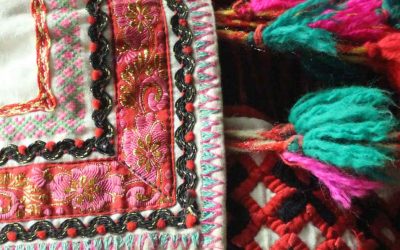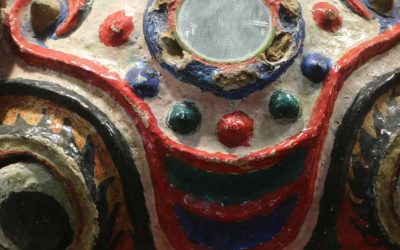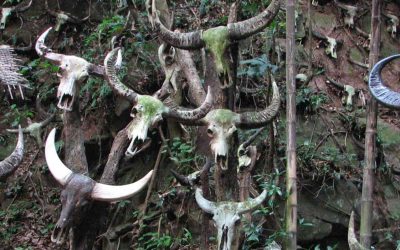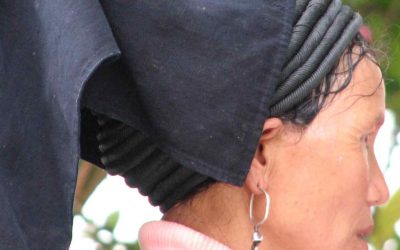The Monastery of Sera – History and foundation
Sera Monastery, located on the outskirts of Lhasa, is one of the largest monasteries in Tibet, and one of the most important centers of learning. Still today many young Tibetans come to the monastery to be trained in the mysteries of Tibetan philosophy and religion, and on visits to this monastery, included in most tours, it is normal to have the opportunity to see monks discussing aspects of doctrine, or some of the printing press rooms that once made this center of learning famous.
Here we have selected part of the article that the Hindu Tibetologist Sarad Chandra Das wrote in 1905 about the monasteries of Tibet (Journal of the Asiatic Society of Bengal.).
The monastery of Sera (literally, wild rose) was founded by Cham-chen-choije Sakya Yeceg in 1418, the year of Tsongkhapa’s death.
The Governor Nehu-pa who patronized Tsongkhapa and his disciples frequently used to invite them to Sera-tse, a retired hermitage on the top of the hill overhanging Sera. On these occasions, Choije devotedly served the reformer, in consequence of which Tsongkhapa predicted a great future for a monastery which Choije would found in that neighbourhood. A saintly Lama while sitting in meditation, cast his eyes on a spot lower down the hermitage which was filled with wild rose plants in blossom. He predicted that someday there would be a monastery there.
Visit to Beijing
Emperor Yongle of the Ming dynasty had sent an invitation to Tsongkhapa to visit Peking; but the great reformer, finding Choije’s time fully occupied with the more important work of religious reformation, sent Cakya Yeces as his representative. Yongle did honour to the Yellow-cap Church by showing every consideration to this disciple of the reformer on his arrival at Peking where Choige’s first act was to bring about the recovery of the Emperor from a serious illness by the efficacy of his religious services. The temple of Maitreya, then recently built by the Emperor, was placed in his charge and he was given the name of Chyam-chen Choije. Under the Imperial auspices, Choije founded the monastery of Hwang-si (Yellow-temple) in one of the imperial gardens of Peking situated a few miles to its north. For diffusing the reformed creed of Tsongkhapa in China he had taken with him several of Tsongkhapa’s works and a set of block-print Kahgyar [113] scriptures. After converting the Lamas of Peking to the reformed Yellow-cap Church he returned to Tibet. On the way, he paid his reverence to Tsongkhapa making rich presents to him. Subsequently, he founded the monastery of Sera Theg-chen-ling, which now contains 5,500 monks and exercises much influence in the secular and religious administration of the country.
Sera University
He established a university in it with four Tva-tshang or colleges. Of these Gya-Tva-tshang belonged to the upper division of Sera and the remaining three, i.e., Thoisam, Norpuiling, Chyipa Khamang Tva-tshang, and Nag-pa Tra-tshang belonged to Sera Mah, (sma) z.e., lower division of Sera. In the middle of the eighteenth century, two of the colleges were established. It still continues to be a favourite resort of learned men of Tibet and Mongolia. The monks of Sera belong to respectable families of Tibet proper, Amdo, Kham, Nyagrong, Mongolia, and Western China.
Main art treasures
There are in the Dukhang (grand hall of the congregation) the images of —
- Buddha vanquishing Mara the evil one and a host of demons.
- The sixteen Sthavira (Neh-tan Chu-rig!) brought from China.
- Several life-like images constructed by the famous artist Nehu Chang-wa.
In the Gonkhang (the temple assigned to the Tantrik deities) there are—
- The image of the six-armed Bhairava, constructed by Leg-an of Shwau.
- Gon-po Choigyal with four arms.
- The goddess Paldem Lhamo (Kali) on horseback, her legs being tied by a chain, probably as a punishment for her wicked conduct.
In the front wall, there are painted representations of the invasion of U by the Tsang army and their defeat by the Tartars in 1643, the scenes of war, and the images of fearful spirits, such as Gon-po De-mar, the genius (Chyarog-dong-chan, he with a raven’s head), etc. On the western wall are painted the likenesses of the successive high priests of Sera, etc.
In the western corner of the upper congregation hall (Duk-hang Gong-ma), are the images of Amitabha Buddha, the eleven-armed Avalokitesvara and the four-armed Gon-po, Maitreya made of silver, the Bodhisattva (Cakya) as a citizen, and the eight spiritual sons of Buddha and also the Kah-gyur and Tangyur collections, all written in gold and silver.
In the temple of Chyam-chen Shal-reh Lhakhang, the image of Atisha with a Chintamani wishing-gem in his hand is conspicuous.
In the Go-chye-khang there are images of Buddha and a silver Chorten. In the further niché of the Dukhang there is a golden image of the coming Buddha. In the front hall of the ukhang there are the Dharma Pala. The most remarkable object in the passage of circumambulation round the monastery is a small Chattya (said to be one of the 84,000 chattya constructed by Emperor Asoka) which was brought from Magadha. There is also a Tantrik image of Hayagriba with the goddess Vajra Varéhi in his clasp.
Last posts
The goddess of the Sun of the Jingpo
The goddess of the Sun of the Jingpo The goddess of the Sun was in the sky when one day she realized that on Earth the situation of men had changed a great deal. When they were created, they were all equal, and without evil and they did not covet riches. The latest...
Funeral Masks of the Zhuang people in the Nationalities Museum of Kunming
Funeral Masks of the Zhuang people in nationalities Museum of Kunming Known as Longyawai Masks, they are funeral ceremony masks popular in the Zhuang communities of Wenshan Autonomous Prefecture, on the east of Yunnan Province. The masks are shaped as a lion, they are...
The creation of the world among the Wa of China
The creation of the world among the Wa of China As soon as the heaven was formed, it looked like the back of a toad, full of lumps and protrusions, it was very ugly. The god Li[i] extended his hands and was polishing without stopping. Nobody knows how many years he...
The Jinuo, descendants of the uncle
The Jinuo, descendants of the uncle The Jino, with a population of only 21.500 persons (in 2005) are one of the smallest minorities in China and the last to be officially recognized as such, as they were designated a national minority and granted the special rights...
The Blue Women of China of the Yao minority
The Blue Women of China of the Yao minority Many people have heard of the Blue Men of the Sahara (the Tuareg), but few have heard of the Blue Women of China. And in fact among the women of the so-called Landian Yao or Landen Yao outside China, the production, dyeing...
The Landing Yao Ancestral Festival of July
The Landing Yao Ancestral Festival of July All around China, the seventh month of the lunar calendar is known as the month of the ghosts, because in this month is celebrated the Mid-Year Festival. The Mid-Year Festival has nowadays many variations and it includes a...










